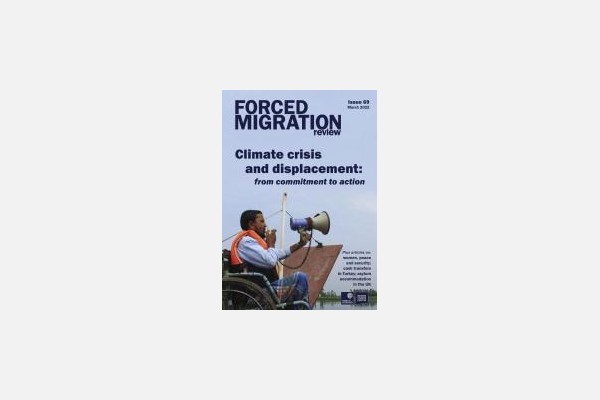Repository of Practices

Developing partnerships in the IGAD region
Dates
Type of practice
Geographic scope
Regions:
Summary
As recognised in the Global Compact for Migration (GCM), no country can address the challenges and opportunities of human mobility on its own, nor can it be addressed by any single policy sector alone. This is particularly true in view of the diversity and complexity underpinning the movement of people in disaster and climate change contexts. Risks and protection needs faced by these groups can be addressed through a number of measures and tools, including regular pathways for migration, integrated approaches to disaster risk reduction (DRR), climate change adaptation and resilience-building, measures to support decent work and livelihoods, and migration as an adaptation strategy.
To this end, a number of UN agencies and partners established a Joint Programme in February 2021 (funded under the Migration Multi-Partner Trust Fund) to improve regional and national migration governance in the context of the adverse impacts of climate change and environmental degradation. This partnership aims to contribute to implementing relevant international instruments and presents a unique opportunity to bring together the shared expertise and experience of different State and non-State actors in the IGAD region.
Particularly the partners will support the regional and national actors to:
1) Generate data to better map, understand, predict and address migration movements and the risk of displacement;
2) Include disasters, the adverse effects of climate change and environmental degradation in national and regional migration and mobility policies, as part of climate change and disaster preparedness strategies;
3) Strengthen preparedness and response capacity and coordination, through regional, sub-regional and bilateral cooperation; and
4) Support implementation of regional and national human mobility frameworks to enhance availability and flexibility of pathways for regular migration, and for those displaced in the context of disasters, the adverse effects of climate change and environmental degradation – particularly for female migrants.
Organizations
Main Implementing Organization(s)
Detailed Information
Partner/Donor Organizations
Benefit and Impact
o Partners have worked together to develop disaster displacement risk profiles on agreed risk metrics, which cover floods and cyclones in Somalia, South Sudan and Sudan. The results are integrated on an ongoing basis into existing ICPAC products, including ICPAC's East Africa Hazards Watch and the ICPAC Geoportal, which supports the validation of the reliability and effectiveness of the risk profiles. Results are already discussed with wide range of stakeholders in the Greater Horn of Africa Climate Outlook Forums (GHACOF).
o To enhance capacities of IGAD and ICPAC and the sustainability of the programme results, ICPAC recruited a Mobility Analyst on disaster displacement. The Mobility Analyst further finalized an Action plan which defines how ICPAC will incorporate human mobility within their programs and expand its coordination to the existing IGAD platforms, to enhance sharing the results of the joint intervention with different stakeholders, including IGAD Member States.
o To enhance the evidence base of facilitating pathways for regular migration and minimizing displacement risk in the context of climate change, environmental degradation and disasters, the programme partners have already commenced several studies: i) on the needs and opportunities for a stronger integration of human mobility in regional and national green economy and related policies and plans, ii) on what protection frameworks and coordination mechanisms for implementation exist to respond to human mobility related to climate change and disasters in the IGAD region and iii) on a stronger integration of human mobility in local and national climate change and disaster risk reduction policies and plans, in Kenya and Somalia.
o The programme is currently in the process of engaging local NGOs to support the implementation of the recommendations from aforementioned studies with local communities. In Kenya for example, mobility considerations will be incorporated in the local Climate Change Action plan in consultation with local communities. The community projects also support the engagement of local communities in green economy developments and sustainable livelihoods, enhancing their adaptive capacities to climate change.
Key Lessons
Recommendations(if the practice is to be replicated)
Innovation
To support policy-making processes, evidence is key. The Joint Programme is developing innovative solutions to addressing data gaps, and risk modelling is one of them.
Many of the Programme components could be easily replicated or scaled up in other locations facing similar challenges, bearing in mind that all interventions must be tailored to the local context and realities.
Additional Resources
Additional Images
Date submitted:
Disclaimer: The content of this practice reflects the views of the implementers and does not necessarily reflect the views of the United Nations, the United Nations Network on Migration, and its members.
More Related Practices:
- Strengthening the capacities and frameworks to collect data and evidence on migration, the environment and climate change (MECC) in Mexico
- Disaggregated Data Action Plan (DDAP) - Statistics Canada
- Immigration, Refugees, and Citizenship Canada’s Use of Gender Based Analysis Plus (GBA Plus)
- Tablero Interactivo Estadísticas sobre Movilidad y Migración Internacional en México
- International Labour Migration Statistics (ILMS) Database in the Association of Southeast Asian Nations (ASEAN) region
Peer Reviewer Feedback:
*References to Kosovo shall be understood to be in the context of United Nations Security Council resolution 1244 (1999).
Newsletter
Subscribe to our newsletter.
